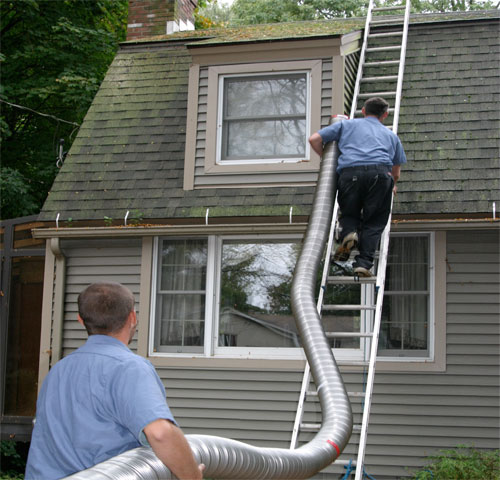There are more components of a chimney than homeowners realize, which can make the prospect of interior chimney repairs confusing. When your chimney sweep tells you that your needs a fix on the inside, it can be difficult to comprehend what’s going on. To avoid being caught unaware, here are some common interior chimney repairs you should know about.
Smoke Chamber Parging
Just above your firebox sits your smoke chamber. The smoke chamber serves as a funnel, guiding smoke upward and inward from the firebox to the narrow chimney flue. Many smoke chambers are constructed from firebrick “steps,” bricks that are staggered upward and inward to make the funnel shape. The problem with these smoke chambers is that the smoke bounces around inefficiently, interfering with a proper chimney draft. To solve this problem, or to smooth out cracks or defects in the smoke chamber, parging is often prescribed. With parging, special refractory cement is used to smooth the surface of the smoke chamber. This allows for smoother, more efficient drafting and to eliminate defects.
 Chimney Relining
Chimney Relining
Chimney liners will break down over time, and when they do, they can fail to contain the heat and flames in your chimney. Whether due to water damage or due to a chimney fire, a failing chimney liner must be replaced. If your chimney needs to be relined, you have two primary options.
- You can have a stainless steel chimney liner inserted,
- or the chimney can be resurfaced with a specialized cerfractory sealant that fills in any cracks or gaps and restores the strength of the chimney liner.
Damper Replacement
Most chimney dampers are located right about the firebox, at the base of the chimney throat. These dampers feature a metal-on-metal fit that quickly warps when exposed to moisture or the extreme heat of your fireplace. A faulty chimney damper can let cold drafts enter your home. They might even become jammed and difficult to open and close. In these cases, a new chimney damper is recommended. When chimney dampers need to be replaced, sweeps almost always recommend a top-sealing chimney damper, which is placed on top of the chimney flue and does a better job than traditional throat dampers of keeping out the cold and moisture.
Lintel Fill
The lintel is the top, front face of your fireplace. It bears the load for the top of the fireplace structure. Where the lintel meets the firebox, there is — or should be — a section of mortar that seals the joint. Because mortar will crumble over time, lintel fills are a common interior chimney repair. With a lintel fill, the mortar in the gap between the rear of the lintel and the front of the firebox is replaced. This replacement keeps the chimney drawing properly and prevent damage or a fire from smoke or embers finding their way into the gap.
How do you know if you require these common repairs? With an annual chimney sweeping and inspection! If your fireplace and chimney are overdue for an inspection, call Fluesbrothers Chimney Service to schedule your chimney sweeping and inspection today.



